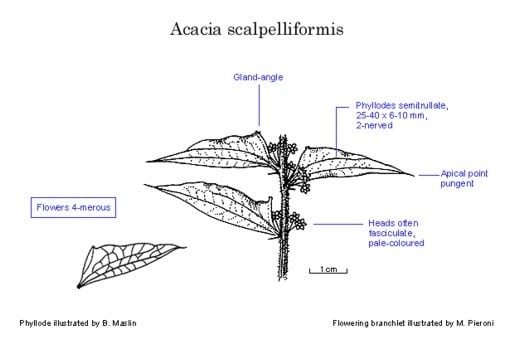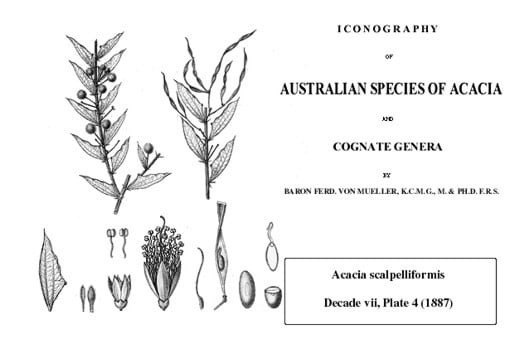Acacia scalpelliformis Meisn.
WATTLE
Acacias of Australia
Family
Fabaceae
Distribution
Occurs at a few disjunct localities in the Pemberton–Manjimup and Augusta districts and near Mt Chudalup, south-western W.A.
Description
Closely allied to A. urophylla but differing principally in the following ways: Phyllodes semitrullate, with a prominent gland angle on the scarcely crenulate adaxial margin 8–11 mm above the base, with base not protracted, 2.5–4 cm long, 6–10 mm wide, pungent, 2-nerved per face; lateral nerves few, not prominent. Pods and seeds not seen.
Habitat
In the Manjimup area it occurs as scattered individuals in dense populations of A. urophylla; it seems to prefer damper sites than A. urophylla.
Specimens
W.A.: Mt Chudalup parking area, off Northcliffe–Windy Harbour road, R.W.Goodman 221 (Albany Regional Herb.); Brockman Block, Pemberton, 27 Oct. 1959, O.W.Loneregan (PERTH); Augusta, 5 Oct. 1968, J.Pocock s.n. (AD); ?Kochelaa’s Gully, 25 Sept. 1967, Forests Dept. Manjimup no. 380 (PERTH).
Notes
Acacia scalpelliformis is not far removed from the ‘A. myrtifolia group’, as shown especially by its 4-merous flowers, even though it has more than one nerve per phyllode (see J.Vassal, Bull. Soc. Hist. Nat., Toulouse 108: 1–127 (1972)). It has been suggested by some field workers that this species might represent a hybrid involving A. divergens and A. urophylla.
FOA Reference
Data derived from Flora of Australia Volumes 11A (2001), 11B (2001) and 12 (1998), products of ABRS, ©Commonwealth of Australia
Author
B.R.Maslin
This identification key and fact sheets are available as a mobile application:
URL: https://apps.lucidcentral.org/wattle/
© Copyright 2018. All rights reserved.








